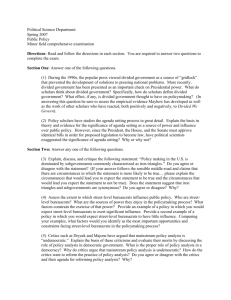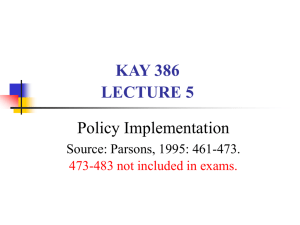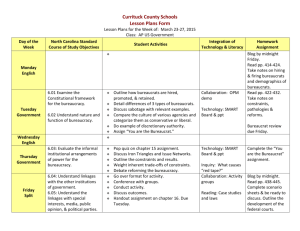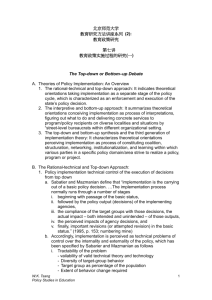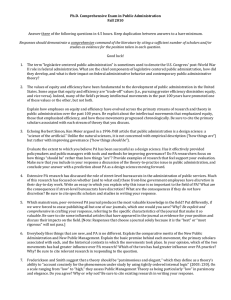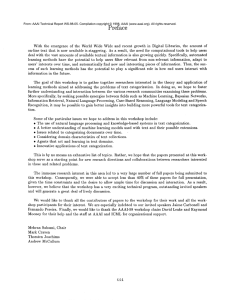About the project
advertisement
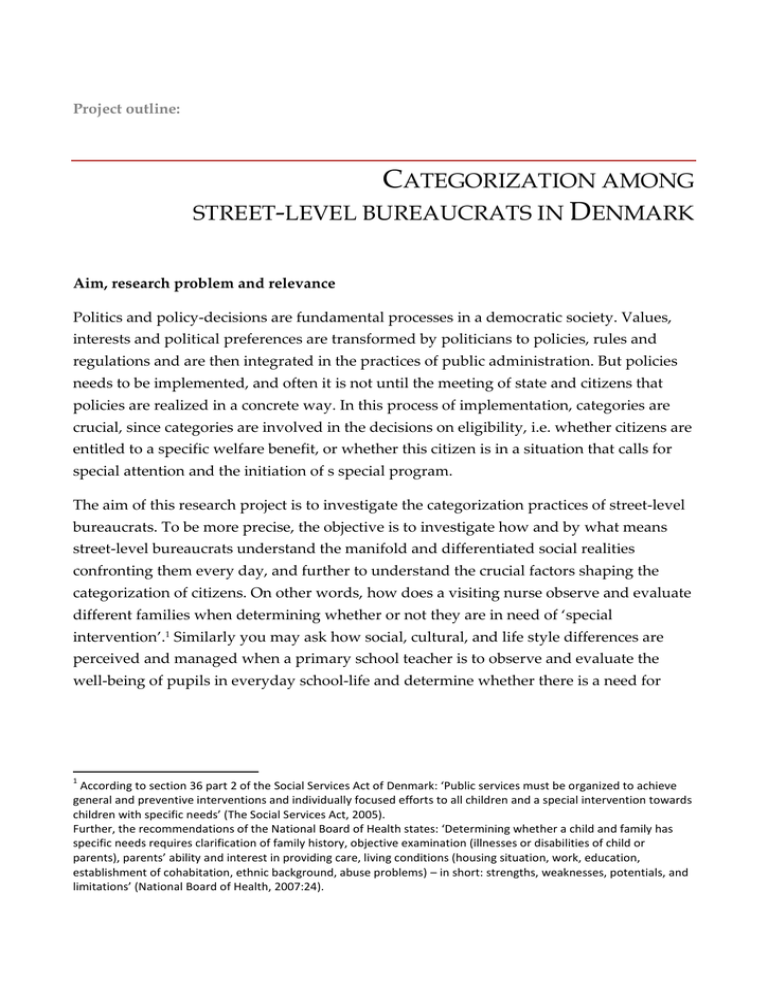
Project outline: CATEGORIZATION AMONG STREET-LEVEL BUREAUCRATS IN DENMARK Aim, research problem and relevance Politics and policy-decisions are fundamental processes in a democratic society. Values, interests and political preferences are transformed by politicians to policies, rules and regulations and are then integrated in the practices of public administration. But policies needs to be implemented, and often it is not until the meeting of state and citizens that policies are realized in a concrete way. In this process of implementation, categories are crucial, since categories are involved in the decisions on eligibility, i.e. whether citizens are entitled to a specific welfare benefit, or whether this citizen is in a situation that calls for special attention and the initiation of s special program. The aim of this research project is to investigate the categorization practices of street-level bureaucrats. To be more precise, the objective is to investigate how and by what means street-level bureaucrats understand the manifold and differentiated social realities confronting them every day, and further to understand the crucial factors shaping the categorization of citizens. On other words, how does a visiting nurse observe and evaluate different families when determining whether or not they are in need of ‘special intervention’.1 Similarly you may ask how social, cultural, and life style differences are perceived and managed when a primary school teacher is to observe and evaluate the well-being of pupils in everyday school-life and determine whether there is a need for 1 According to section 36 part 2 of the Social Services Act of Denmark: ‘Public services must be organized to achieve general and preventive interventions and individually focused efforts to all children and a special intervention towards children with specific needs’ (The Social Services Act, 2005). Further, the recommendations of the National Board of Health states: ‘Determining whether a child and family has specific needs requires clarification of family history, objective examination (illnesses or disabilities of child or parents), parents’ ability and interest in providing care, living conditions (housing situation, work, education, establishment of cohabitation, ethnic background, abuse problems) – in short: strengths, weaknesses, potentials, and limitations’ (National Board of Health, 2007:24). 2 ‘special intervention’.2 The research project will contribute to answer these types of questions. Hence, the main research question on the project is: What determines and conditions the categorization of street-level bureaucrats, i.e. the way in which citizens are categorized in relation to a specific regulation? This problem will be studies at the individual level using semi-structured interviews with street-level bureaucrats from three areas, i.e. health (nurses), day-care (day-care workers) and education (primary school teachers). The point of departure for the project is the expectation that the street-level bureaucrats’ categorization most probably will be affected by formal and informal rules such as legal rules and regulations as well as administrative and professional norms. At the same time, however, we claim that the perceptions, norms and lifestyles of the individual street-level bureaucrat also will affect the categorization, and that this relation will be further conditioned by other factors such as practical experiences of diversity and perceptions of solidarity. Hence, the central claim of the project is that citizens are categorized also on the basis of the norms, values and social perceptions that exist among street-level bureaucrats such as teachers, nurses and day-care workers. But the further claim is that experiences with diverse groups of citizens as well as specific perceptions of solidarity can work against the impact of norms and perceptions. Consequently, the focus of the project will not be on formal and informal rules (which we will hold constant) but on the relationship between lifestyles (values, norms and perceptions) and categorization. This problem has previously been examined with regard to social policies (Järvinen 2007; Järvinen et al 2002, Mik-Meyer 2004; Järvinen & Mik-Meyer 2003, Carstens 1998, Caswell 2005). However, street-level bureaucrats’ categorization practices has only been studied to a very limited extent when it comes to what may be referred to as the ‚normal area‛, i.e. policy-areas where the state potentially meets all citizens (such as health and education). Even though such policies may be described as welfare services (as opposed to both transfers and regulation), street-level bureaucrats (in Denmark at least) will in many instances have the choice to intervene in a more or less radical way. Consequently, this project will contribute with more knowledge regarding the implementation and categorization within these policy-areas. 2 Such ’interventions’ may take very different forms from informal dialogue with parents to contracts concerning pupil action plan to reports to Educational and Psychological Counseling (cf. the Primary Education Act, 2007, sections 4 and 13; Orders on pupil action plans, 2006; and Order on remedial instruction in the primary school and other special educational assistance, 2005). 3 In sum, the project will contribute to our knowledge on categorization as an important mechanism in the implementation of (welfare) policies. Furthermore, we seek to point towards recommendations on how to design processes of implementation in a way so that the impact of private norms and perceptions will be minimal. This, we think, must be a central aim in a democratic society. Thus, the knowledge produced in this project will be relevant for both researchers of the welfare stats as well as practitioners of different ‚welfare professions‛. The contribution of the project The interaction between street-level bureaucrats and citizens may take many forms including exercise of authority (control/regulation, or allocation of services/benefits) or production and delivery of services (Nielsen 2007: 161). But within the production and delivery of services, a more or less explicit regulation of the lives of citizens will also take place, for example in the form of preventive program within health care or programs aimed at working against social reproduction. This type of regulation may be radical, as when state authorities decides to forcibly remove children or dictate a treatment process. But the regulation may also be carried out through a much ‘softer’ and ‘pedagogical’ intervention, e.g. in the form of dialogue or guidance. It is this ‚soft regulation‛ that is of particular interest to this project. But is it necessarily so that the implementation of these ‘soft policies’, trying to influence everyday lives of citizens, will have the desired effect? Preliminary experiences of breaking with social reproduction indicate otherwise. Here, on the contrary, it looks as if welfare institutions are contributing in strengthening or maintaining social reproduction (Ploug, 2005, 2007). Research pinpoints that, among other things, the street-level bureaucrat’s (e.g. the teacher) categorization of citizens (e.g. the pupils) based on teacher’s perception of ‘the normal child’ will contribute in maintaining social differences in relation to resources and status. In contrast, categorizations based on a pluralistic and inclusive understanding of the childrens resources appear to contribute to counteracting social reproduction. Similarly, other researchers stress how categories such as gender and ethnicity are maintained in the practice of institutions even though securing equal rights and integration is an explicit educational goal (Gulløv &Bundgaard, 2008a, 2008b; Palludan, 2008; Staunæs, 2004). Finally, international research highlights how family policies maintain a social exclusion because families are categorized and evaluated on the basis of 4 their disadvantages in relation to a more or less explicitly defined middle class norm (Gillies, 2005, 2007). Thus, it seems that the street-level bureaucrats’ categorization practice is important to the implementation and effect of a policy. However, apart from the studies mentioned, methodical knowledge about how and why street-level bureaucrats across policy areas are categorizing the way they do, is scarce. This project does not examine the entire implementation process, or the effects in the form of the final outcome. But the investigation of the street-level bureaucrats’ categorization practice may contribute with knowledge about an essential part of the implementation process, which so far seems to appear as a ‘black box’. The theoretical point of departure and explanatory model of the project The project takes its point of departure from the theory of street-level bureaucrat behavior and in the notion that their discretion implies that a given policy is not fully elaborated until the meeting between public employees and citizens. Consequently the study of public policy must focus on so-called street-level bureaucrat behavior (see e.g. Lipsky, 1980; Nielsen, 2007; Winter & Nielsen, 2008, Carstens, 1998). Within the literature, the concept of street-level bureaucrat behavior is rather broadly defined and covers actions from authorities, specific defence mechanisms, and the relations between street-level bureaucrats and clients/citizens (Nielsen, 2007: 151). The focus of the project is narrowed down to examine street-level bureaucrats’ categorization practices and is thus about the relation between the street-level bureaucrat and citizen. Further, the explanatory model and expectations of the project primarily have to do with characteristics of the street-level bureaucrats. This focus will, of course, be mirrored in the specific choices of literature. First, the project draws on the literature studying categorization. Here it is pointed out that categorization cannot be understood solely as a technical, administrative decision. Instead, the street-level bureaucrat’s categorization of citizens is defined as a social and political process in which arbitrary differences between citizens are reduced and constructed into one particular difference which then forms the basis of the categorization. And once the client has been categorized thus, the street-level bureacrat’s observations and judgments are shaped by it (Stone, 1984; Brodkin, 1993; Schneider & Ingram, 1993). Among other things, research in categorization shows how there is a connection between strereotyped perceptions of certain groups in society (e.g. white single mothers/black single mothers) and the street-level bureaucrats’ use of discretion towards the citizens. Thus, results show that collective categories such as stereotypes, which may be distinct 5 from the street-level bureaucrat’s personal attitude, the intention of law, and administrative or professional norms, do in fact matter to the street-level bureaucrat’s categorization practice (Brodkin, 1993, see also Stone, 2002: 165). Second, the project draws on studies interested in mechanisms and processes in the meetings of street-level bureaucrats and clients (Järvinen, 2007; Mik-Meyer, 2004; Järvinen et al 2002; Mik-Meyer & Järvinen, 2003; Carstens, 1998, Sløk & Villadsen, 2008). But whereas this literature typically looks at the citizens as a ‚legal subject‛, this project will focus on the many differences between citizens which necessarily must be handled at this level of the implementation process. The third point of departure for the project is the parts of street-level bureaucrat literature which examine how private characteristics of street-level bureaucrats influence street-level bureaucrat behavior. This includes, for example, theories of representative bureaucracies, studying the impact of demographic features (e.g. gender or ethnicity) on the implementation of public policies (e.g. Dolan 2000, Keiser et al. 2002, Meier & NicholsonCrotty 2006). However, these studies focus on demographic features whereas as the present projects will be more interested in the lifestyles, and especially norms, values and habits, of street-level bureaucrats. Further, we draw on the few existing studies of the impact of private characteristics on street-level bureaucrat’s behavior in a Danish context (see e.g. Beer et al., 2008: ch. 10; Winter & Nielsen, 2008: 133-141). Among other things, these studies lok upon the importance of tolerance and aversion, and the present project will try to elaborate on this distinction. Finally, we also include results from an American qualitative study (Maynard-Moody & Musheno 2003, 2000). Here, it was examined how street-level bureaucrats, when evaluating citizens, follow both formal (i.e. institutionalized) rules and social and cultural norms, and the study demonstrates how the concrete evaluation of ‚who the citizen is‛, i.e. the evaluation of the identity, values and moral character of the citizen, is part of the total evaluation and decision. All these literatures dealing with street-level bureaucrats are concerned with mechanisms and relations that are also central in the broader sociological literature, especially literatures dealing with class, gender, ethnicity and the formation of groups. From this sociological literature, we include Bourdieu’s understanding and analysis of habitus, understood as systems of dispositions (norms, values, cognitive schemes and perceptions of normality), and lifestyles, i.e. symbolic groups sharing habits and practices (e.g. Borudieu 1996: 1-53, 1990: 80-97, 1984: 169-175. See also Durkheim & Mauss 1963 and Weininger 2002). In the relational perspective of Bourdieu, the main expectation will be 6 that habitus is structured by the differences between social class positions and an the same time will function as structuring in relation to lifestyles. Further, habitus and lifestyles will function as a classificatory scheme in the judgment of other lifestyles. Thus, we perceive the world and other social agents on the basis of our own position in the social and symbolic relations of a society. In a study of Higher Education in France, Bourdieu demonstrates among other things how academic classifications (i.e. grading of students) to a high degree are homologous with socially conditioned classifications. Also the study found that it seems to be the difference between the life styles and habitus of the academic examiners and the life styles and habitus of the students, which determine the academic classification (Bourdieu 1996). The dynamics in the relation between life styles are further conceptualized and examined within research on ‘symbolic boundaries’ (e.g. Lawler, 2005; Sayer, 2005; Skeggs, 2005; Skeggs, 1997; Lamont & Fournier, 1992). There is much indication that symbolic groupings are maintained through a symbolic activity of making boundaries, a process that entails continuous aesthetic and normative evaluation (cf. Sayer, 2005) of the life styles of other groups. Interesting here is how the mechanisms in the maintenance of classifications often deals as much with dissociation, distaste, and dis-identification as it deals with positive identification and recognition (Prieur, 2008; Savage, 2000). With regard to the central problem of the present project, we expect that the habitus (mental classification scheme) and life style (symbolic classification scheme) of the streetlevel bureaucrat will be significant to his/her perception of the habitus and lifestyle of the citizen, and secondly that this immediate social judgement and identification/disidentification will be crucial for the categorization. In sum, the project’s explanatory model can be summed up as follows: 7 Figure 1: Basic explanatory model SBL’s judgement of the habitus and lifestyle of the citizen (symbolic boundaries) SBL’s categorization The primary hypothesis of the project may be presented as follows: H1: Street-level bureaucrats’ categorization is decided by the interaction between habitus and lifestyles and the the judgement of the habitus and lifestyles of the citizen. The categorization of the citizens will thus reflect the street-level bureaucrat’s symbolic boundary drawing between him/herself at the citizen. And in contrast to this main hypothesis a competing hypothesis can be formulated regarding institutional autonomy (e.g. Lægreid & Olsen 1978; March & Olsen, 1999; Järvinen & Mik-Meyer 2003): H2: Street-level bureaucrats’ categorization is decided by formal rules and formal as well as informal norms. The categorization will thus convey an institutional logic. The impact of institutions will not be studied in this project, though. Similarly, we will not study what determines the habitus and lifestyles of the street-level bureaucrats or the possible counter-strategies taken up by citizens. And finally, we will not focus on the implementation of policies (i.e. what happens after the initial categorization) or policy effects. Instead, the research design aims at keeping the degree of institutionalization constant understood as the degree of regulatory requirements, the degree of fixed administrative routines, and the degree of professional norms. Put differently, study will focus on categorization in policy areas where the discretion is large, the institutional regulation is weak, and where the degree of professionalization is not noticeably high. It 8 should be emphasized, however, that the institutional regulation of the form of the tasks may be strong, not necessarily implying that the regulation of the content and the actual accomplishment of the tasks are strong as well. By way of example, this situation applies to the pupil’s plans in primary school. What is crucial to the problem definition and design of the project is thus primarily the institutional regulation of the contents of the tasks including the specific categorization. In turn, two other conditional variables are examined: the diversity in the group of citizens, and the tolerance towards difference of the street-level bureaucrats. Thus, another two hypotheses are examined; both of which are connected with what in a wide sense may be called social differentiation and integration/solidarity. The hypotheses are further described and substantiated in connection with the subprogram. Consequently, the enlarged explanation model of the project is presented as follows: Figure 2: Expanded explanatory model SBL’s experiences with diversity in the group of citizens (Sub-project 1) SBL’s judgement of the habitus and lifestyle of the citizen (symbolic boundaries) SBL’s tolerance towards difference (Sub-project 2) SBL’s categorization 9 Research strategy, design, and choice of method The research strategy of the project is qualitative and comparative, using especially semistructured qualitative interviews. First, the method is motivated by the fact that streetlevel bureaucrat’s categorization has a practical character, and hence must be measured (or captured) in the street-level bureaucrats’ actions (their behavior) and in the ‚thought processes‛ ) involved in actions. Furthermore, there seems to be a widespread consensus within sociological literature that qualitative research strategies are suitable for research of habitus (e.g. Weininger 2002). Since both researchers are experienced with regard to collection and analysis of qualitative interview data, the goal will be to collect a relatively large number of interviews (appr. 60), which is particularly important if we are to be able to test the proposed model. As mentioned above, the project will be designed to keep the degree of institutionalization constant. This is done by choosing three policy areas where the discretion is weakly regulated and where the education of the street-level bureaucrats is the same (3-4 years of higher education), pointing towards a not to high degree of professionalization. These policy-areas are, as mentioned above, health (home nurses), education (primary school teachers) and day-care (day-care workers). At the same time, the design will aim at maximizing – if possible – the variation on the independent and dependent variables. This is the case with the habitus and lifestyle differences in the group of citizens, where variation can be constructed using vignettes, and also the case with the street-level bureaucrat’s experience with diversity, which can be approximated by selecting street-level bureaucrats from areas with varying degrees of difference. As for the other variables (i.e. the habitus, lifestyles and tolerance of street-level bureaucrats), this cannot be controlled in advance. Here we will use theoretical sampling, aiming for maximum variance (Gerring 2007) using snow-balling as a sampling technique (David & Sutton 2004; Miles & Huberman 1994). This technique suggests to ask interviewees to point out other possible interviewees with different backgrounds and lifestyles. Furthermore, the project will employ ‘cross-case analysis’; i.e. analyses concentrating on the variation in the variables in the explanation model, and ‘within-case analysis’ which seeks to expose causal mechanisms by tracing processes within the case (George & Bennet, 2005: 151-179; Gerring, 2007: 43-48, 204-207). 10 SUB PROJECT 1: STREET-LEVEL BUREACRAT’S EXPERIENCES WITH DIVERSITY AMONG CITIZENS (GITTE SOMMER HARRITS) Sub project one examines the effect of street-level bureaucrat’s experience with diversity among citizens, expecting that such experiences with differences in lifestyles among citizens will influence the categorization. One way of founding this expectation is in Durkheim’s conception that functional differentiation and increases in differences will affect the way in which people relate to each other, i.e. the form of solidarity (Durkheim 1984: 85). Similarly, Schütz argues that our perceptions of others are dependent upon the way in which we gain knowledge of these others, i.e. whether we gain knowledge through collective representations (stereotypes) or through face-to-face interaction (Bottero 2005: 24). Theoretically, one can thus expect, that the concrete meeting with many different lifestyles will make it difficult to uphold a narrow conception of one’s own norms and lifestyle s ‚normality‛. Empirically, this expectations seems to be supported by findings showing how heterogenic groups of students effect the individual academic performance of students (Andersen 2008, Rangvid 2007) and thus the social reproduction within schools (Olsen 2009). The hypothesis in sub-project 1 is therefore: H3: Street-level bureaucrat’s experiences with diversity among citizens will weaken the relationship between street-level bureaucrats’ habitus/lifestyle and their categorization, whereas experiences with homogeneous groups will strengthen this relationship. Evidently, examination of the project hypothesis depends on measurement of the central variables. Operationally the independent variable (SBL’s habitus and lifestyle) will be measured by asking questions about the interviewees everyday life, and by confronting the street-level bureaucrat with different vignettes, realistically describing meetings woth citizens (Egelund & Thomsen, Møller 2009, Barter, C.. & E. Renold, 1999). 11 Variable Street-level bureaucrat’s life style and habitus Habitus and lifestyles of citizens Perception of cases / judgment Categorization Reasons for categorization Experience of diversity Examined by How is the street-level bureaucrat’s everyday life organized and practiced in terms of norms, values, habits, conceptions of normality and practices. Example of questions Can you describe a ‚normal week‛? What do you do, when you are not working? Try to tell something about yourself and your friends. What ‚types of people‛ do you normally hang out with? Do you have children? What do you think is most important to teach (your) children? Presentation of vignettes Elements that could be varied in vignettes: Habits of food, consumption, religious practices, organization of family life, norms on child-rearing, conceptions of and relations to the body How does the street-level bureaucrat Do you know a client (family) as the characterize the case? Which one described here? What do you characteristics are noticed by the street- think about it? Is it an easy or a level bureaucrat and what is his or her difficult family for you to evaluate? attitude towards and evaluation of these What do you find particularly characteristics ? interesting here? Would you describe this client (family) as normal? How would you compare this client (family) to yourself (your own family)? How would the street-level bureaucrat What do you think you would do in categorize this case? this case (if anything)? Does this fall under the legal framework covering your work? How? What do you think will happen further on? Which justification is given for the Why is it that you think something suggested categorization? Are life style should be done here? What in the characteristics from the case included? regulation in your field is relevant Is the justification based on clear here. Are there other reason? What institutional and professional standards do you think the measures that you or by reference to social or cultural are suggesting will contribute to? norms relating to the street-level bureaucrat’s own life? Is handled at the level of sampling, Is also controlled by asking the approximated by social characteristic at street-level bureaucrat to describe the level of local areas regarding the area that he/she is working in: income, education, age, and Can you describe the group of occupations. citizens that you typically meet in your work. What kind of neighborhood is this? 12 SUB PROJECT 2: STREET-LEVEL BUREAUCRAT’S COLLECTIVE ORIENTATIONS AND TOLERANCE TOWARDS DIFFERENCE (MARIE ØSTERGAARD MØLLER) Earlier studies of street-level bureaucrat behavior have applied a distinction made by Togeby between aversion and tolerance (Winter & Nielsen 2008: 109). In terms of tolerance towards difference these studies demonstrates how tolerant caseworkers to a higher degree will apply coping strategies and apply measures that are relatively non-interfering in the lives of citizens (Beer et al 2008: 224-237; Winter 2002). Sub project will test the expectation that street-level bureaucrat’s tolerance towards differences will impact the relationship between habitus/lifestyles and categorization. The theoretical point of departure is thus an interest in the impact of collective orientations (Durkheim 1984: 83). To study this relationship this sub project will first contribute with a theoretical discussion and clarification of the notion of tolerance. The distinction between aversion and tolerance can both be seen to connect with a liberal understanding of freedom rights and legal regulations, but also connects with the spontaneous judgments of taste made in the presence of others, i.e. judgments of others lifestyles, norms and practices. In the present project, the question of taste is related to hypothesis one and the basic explanatory model, whereas the question of tolerance is constructed as a conditioning factor (studied in sub project 2). Here the concept of tolerance is connected to theories of solidarity. The point of departure will be Parsons’ Durkheim-inspired concept of collective orientations, which refers to the ways in which the individual orientates him/herself towards a collective community, as well as the types of communities that the individual primarily identifies with (Parsons 1951: 97). Durkheim’s theory on solidarity distinguishes between mechanic and organic solidarity, corresponding to homogenous and heterogeneous communities. Within homogeneous communities cohesion will depend on common norms, whereas in heterogeneous communities cohesion will depend upon common rights and procedures. More precisely, the distinction applied in this project will focus on the type of collective orientations characterizing the street-level bureaucrat: If the street-level bureaucrat primarily identifies him/herself with a homogeneous community corresponding to a mechanical solidarity, it will be expected that categorization will be done on the basis of 13 own norms, perceptions, tastes etc. However, if the street-level bureaucrat primarily identifies him/herself with heterogeneous communities corresponding to an organic solidarity, categorization will be expected to be done on the basis of rules and procedures regulation the way in which to assess the need of the citizen (Durkheim 1984: xl-xlvi). Recent studies within welfare literature have further pointed out how homogeneous and heterogeneous societies are different in terms of the solidarity and legitimacy of welfare states (Jensen 2008, Esping-Andersen 1990). Thus, a hypothethis for sub project 2 can be presented: (H4): Street-level bureaucrats’ collective orientation affects the connection between streetlevel bureaucrats’ habitus/lifestyles and categorization practice, since it is expected that a collective orientation controlled by a mechanical logic will strengthen the relationship, whereas a collective orientation controlled by an organic logic will weaken or remove the relationship. The hypothesis will be investigated by asking about street-level bureaucrats’ collective orientation to establish whether it is mainly mechanical or organic and when a possible mix of the two is present. The central point for measuring collective orientation will be the street-level bureaucrats’ perception of the relation between individual and society, between state and citizen, and the street-level bureaucrats’ perception of the role they are playing in relation to the citizens with whom they are normally in contact. Furthermore, it is investigated how street-level bureaucrats enter into different communities such as e.g. the general Danish society, and more special or smaller communities such as e.g. family, associations (for example trade unions, leisure-time associations) and the importance given to the different communities. Variable Street-level bureaucrat’s collective orientations (e.g. tolerance) Examined by What types of communities does the interviewee identify with? How is community understood, and how is difference perceived and handled? What is the perception of community vs. individual and state vs. citizen, and how does the street-level bureaucrat see his/her own role? Example of questions What do you think others would say about your job? Can you say something about your job and the importance that you have for your clients? What do you think a ‚community‛ is? And what is the opposite of community? What does it mean to be different? Is that a good thing or not so good in your opinion? 14 References Andersen, Simon Calmar (2008): "The Impact of Public Management Reforms on Student Performance", Public Administration, vol. 86, no. 2, pp. 541-558. Barter, C. & E. Renold (1999): ‛The Use of Vignettes in Qualitative Research‛, Social Research Update, Vol. 25 Beer, Frederikke, Søren C. Winter, Mette H. Skou, Mads V. Stigaard, Annemette C. Henriksen & Nina Friisberg (??): Kommunal beskæftigelsesindsats. Implementering af ”Flere i Arbejde” før strukturreformen. København: SFI. Bourdieu, Pierre (1984): Distinction. A Social Critique of the Judgement of Taste. London: Routledge. Bourdieu, Pierre (1990): The Logic of Practice. Stanford: Stanford University Press. Bourdieu, Pierre (1996): The State Nobility. Cambridge: Polity Press. Bottero, Wendy (2005): Stratification: Social division and inequality, London: Routledge. Brodkin, Evelyn Z. (1993): ‛The Making of an Enemy: How Welfare Policies Construct the Poor‛ i Law & Social Inquiry, Vol. 18, No. 4. pp. 647-670. Carstens, Annette (1998): Aktivering, klientsamtaler og socialpolitik. København: Hans Reitzels Forlag. Caswell, Dorthe (2005): Handlemuligheder i socialt arbejde - et casestudie om kommunal frontlinjepraksis på beskæftigelsesområdet. Ph.d.-afhandling, København: AKF-forlag. David, Matthew & Carole D. Sutton (2004): Social Research. The Basics. Thousand Oaks & New Delhi: Sage Publications. Dolan, Julie (2000): ‛The Senior Executive Service: Gender, Attitudes and Representative Bureaucracy‛, i Journal of Public Administration Research and Theory, vol. 10, no. 3. pp. 513-529. Durkheim, Emile (1984): The Division of Labour in Society. London: Macmillan Press Durkheim, Emile & Marcel Mauss (1963): Primitive Classifications. Chicago: University of Chicago Press. Egelund, Tine & Signe Andrén Thomsen (2002): Tærskler for anbringelse. En vignetundersøgelse om socialforvaltningers vurderinger i børnesager. København: SFI. Esping-Andersen, Gøsta (1990): The Three Worlds of Welfare Capitalism. Cambridge: Polity Press. Faber, Stine Thidemann (2008): På jagt efter klasse. ph.d.afhandling, Institut for Sociologi, Socialt Arbejde og Organisation, Aalborg Universitet. Feather, N.T. (2003): ‚Distinguishing between deservingness and entitlement: earned outcomes versus lawful outcomes‛ i: European Journal of Social Psychology, Vol. 33, pp. 367-385 George, Alexander L. & Andrew Bennett (2005): Case Studies and Theory Development in the Social Sciences. London: MIT Press. Gerring, John (2007): Case Study Research. Principles and Practices. Cambridge: Cambridge University Press. Gillies, Val (2005): ‚Raising the ‘Meritocracy’: Parenting and the Individualization of Social Class‛, i Sociology, Vol. 39(5), pp. 835-853 15 Gillies, Val (2007): Marginalised Mothers. Exploring Working Class Experiences of Parenting. Abingdon: Routledge. Gulløv, Eva & Helle Bundgaard (2008a): Forskel og fællesskab. Minoritetsbørn i daginstitution. København: Hans Reitzels Forlag. Gulløv, Eva & Helle Bundgaard (2008b): ‚Children of Different Categories. Educational Practice and the Production of Difference in Danish Day-Care Institutions‛, i Journal of Ethnic and Migration Studies, Vol.32, January 2006 (no.1), pp. 145-155. Harrits, Gitte Sommer (2005): Hvad betyder klasse? En rekonstruktion af klassebegrebet med henblik på en analyse af politisk deltagelse i Danmark. Ph.d.-afhandling, Århus: Politica. Harrits, Gitte Sommer (2006a): ‚Individualizing Welfare and New Social Risks‛, Paper prestented at Store Restrup Herregård, 13.1.2006 - 15.01.2006. Harrits, Gitte Sommer (2006): ‚The Class Thesis Revisited: Social Dynamics and Welfare State Change‛, Paper presented in Bremen, 21.9.2006 - 23.9.2006. Harrits, Gitte Sommer (2007): "Kan fattigdom være kulturel?", i Social Politik, nr. 4, pp. 5-10. Harrits, Gitte Sommer (forthc.): ‚Praxeological knowledge: An integrated strategy for combining "explaining" and "understanding".‛, i Scott-Reinbacher, Gunnar (red.) Research Design. Jensen, Carsten (2007): ‚Fixed or Variable Needs? Public support and Welfare State Reform‛ i: Government and Opposition, Vol.42, No. 2, pp. 139-157. Järvinen, Margaretha, Jørgen Elm-Larsen & Nils Mortensen (2002): Det magtfulde mode mellem system og klient. Århus: Aarhus Universitetsforlag. Järvinen, Margaretha & Nanna Mik-Meyer (2003): At skabe en klient. Institutionelle identiteter i socialt arbejde, København: Hans Reitzels Forlag. Järvinen, Margaretha (2007): ‛ Fra klientgørelse til selvforvaltning – socialt arbejde med etniske minoritetsklienter‛, pp. 93-112 i Vibeke Lehmann Nielsen & Niels Ploug (red.), Når politik bliver til virkelighed. Festskrift til Professor Søren Winter, København: SFI. Keiser, Lael R., Vicky M. Wilkins, Kenneth J. Meier & Catherine Holland (2002): ‚Lipstick and Logarithms: Gender, Institutional Context and Representative Government‛, i: American Political Science Review, Vol. 96, no. 3, pp. 553-564. Lamont, Michelle & Marcel Fournier (1992): Cultivating Differences: Symbolic Boundaries and the Making of Inequalities. Chicago: University of Chicago Press. Lawler, Stephanie (2005): ‚Introduction: Class, Culture & Identity‛, i: Sociology, Vol. 39, no. 5, pp. 797-806. Lipsky, Michael (1980): Street-level Bureaucracy. Dilemmas of the Individual in Public Services. New York: Publications of Russell Sage Foundation. Lægreid, Per & Johan P. Olsen (1978): Byråkrati og Beslutninger. Oslo: Universitetsforlaget. March, James G. & Johan P. Olsen (1989): Rediscovering Institutions. The Organizational Basis of Politics. New York: Free Press. Maynard-Moody, Steven & Michael Musheno (2003): Cops. Teachers, Counselors. Stories from the Front Lines of Public Service. Ann Arbor: University of Michigan Press. 16 Maynard-Moody, Steven & Michael Musheno (2000): ‚State-Agent or Citizen-Agent: Two Narratives of Discretion, i: Journal of Public Administration Research and Theory, Vol 10., no. 2, pp. 329-358. Meier, Kenneth J. & Jill Nicholson-Crotty (2006): ‛Gender, Representative Buraucracy, and Law Enforcement: The Case of Sexual Assault‛, i: Public Administration Review, Vol. 66 no. 6, pp. 850-860. Mik-Meyer, Nanna (2004): Dømt til personlig udvikling. Identitetsarbejde i revalidering. København: Hans Reitzels Forlag. Miles, Matthew B. & Michael A. Huberman (1994): Qualitative Data Analysis. Thousand Oaks, London, New Delhi: SAGE. Møller, Marie Østergaard & Sara Normann Thordsen (red.) (2008), Æstetik og politisk magt. Otte analyser af aktuelle forhold mellem æstetik og politik, Århus: Århus Universitetsforlag (NSU-Press). Møller, Marie Østergaard (2009): Hvilken betydning har smertetype i det sociale system? Viborg: Region Midtjylland. Nielsen, Anne Maj (2007): ‛Skolen og den sociale arv‛, i: Niels Ploug (red.), Social ulighed og social arv. København: Hans Reitzels Forlag. Nielsen, Anne Maj, Kirsten Fink-Jensen & Charlotte Ringmose (2005): Skolen og den sociale arv. København: SFI. Nielsen, Vibeke Lehmann (2007): ‛Indbydelse til dans omkring markarbejderbegrebet‛, pp. 149170 i: Nielsen, Vibeke Lehmann & Niels Ploug, Når politik bliver til virkelighed. Festskrift til Professor Søren Winter. København: SFI. Olsen, Bent (2007): Pædagogik, pædagogmedhjælpere og pædagoger, Viborg: PUC. Olsen, Lars (2009): Den sociale smeltedigel, København: Forlaget Sohn. Parsons, Talcott (1964): The Social System. London: Collier-Macmillian Limited. Palludan, Charlotte (2008): Børnehaven gør en forskel. København: Gyldendal. Ploug, Niels og Jørgen Søndergaard (2007), ‛Hvorfor er der brug for implementeringsforskning?‛, pp. 187-196 i: Nielsen, Vibeke Lehmann & Niels Ploug, Når politik bliver til virkelighed. Festskrift til Professor Søren Winter. København: SFI. Prieur, Annick (2008): ‛Class in disguise, class as disidentification‛, Paper presented at the 24th Conference of the Nordic Sociological Association, August 2008. Prieur, Annick, Jakob Skjøtt-Larsen & Lennart Rosenlund (2008): ‚Cultural Capital Today: A Case Study from Denmark‛, i: Poetics, Vol 36, no. 1, pp. 45-71. Prieur, Annick, Jakob Skjott-Larsen, Gitte Sommer Harrits & Lennart Rosenlund (forthcoming): ‚Class and politics in Denmark. Are both old and new politics structured by class?‛, i: Scandinavian Political Studies. Rangvid, Beatrice S. (2007): School composition effect in Denmark: Quantile regression evidence from PISA 2000, Empirical Economics, 33: pp. 359-388. 17 Savage, Mike (2000): ‛Changing Social Class Identities in Post-war Britain: Perspectives from Mass Observation‛ i: Sociological Research Online, Vol. 12, no. 3, pp. ?? Sayer, Andrew (2005): ‚Class, Moral Worth and Recognition‛, i: Sociology, Vol. 39, no. 5, pp. 947963. Skeggs, Beverly (2005): ‚The Making of Class and Gender through Visualizing Moral Subject Formation‛, i: Sociology, Vol. 39, no. 5, pp. 962-982. Skeggs, Beverly (2004): Class, Self & Culture. London: Routledge. Schneider, Anne & Helen Ingram (1993): ‚The Social Construction of Target Populations. Implications for politics and policy‛, i: American Political Science Review, Vol. 87, no. 2, pp. 334-347. Sløk, Camilla og Kasper Villadsen (red.) (2008): Velfærdsledelse. København: Hans Reitzels Forlag. Staunæs, Dorthe (2004): Køn, etnicitet og skoleliv. Frederiksberg: Forlaget Samfundslitteratur. Stone, Deborah A. (1984): The Disabled State. Philadelphia, Temple University Press. Stone, Deborah A. (2002): Policy Paradox. The Art of Political Decision Making. New York: W.W. Norton & Company. Weininger, Elliot B. (2002): "Class and Causation in Bourdieu‛, i: Current Perspectives in Social Theory: Bringing Capitalism Back for Critique by Social Theory. Vol. 21, pp. 49-114. Willig, Rasmus & Marie Østergaard (red.) (2005): Sociale patologier. København: Hans Reitzels Forlag. Winter, Søren (2002), ‚Explaining Street-Level Bureaucratic Behavior in Social and Regulatory Policies‛. Paper prepared for the Annual Meeting of the American Political Science Association in Boston, 29 August - 1 September 2002. Danish National Institute of Social Research. 32 pp. Winter, Søren & Vibeke Lehmann Nielsen (2008): Implementering af politik. Århus: Academica.
